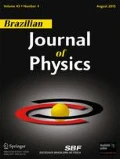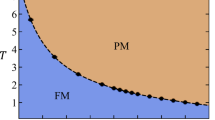Abstract
Recently pseudo-critical temperature clues were observed in one-dimensional spin models, such as the Ising-Heisenberg spin models, among others. Here we report a relationship between the zero-temperature phase boundary residual entropy (critical residual entropy) and pseudo-transition. Usually, the residual entropy increases in the phase boundary, which means the system becomes more degenerate at the phase boundary compared with its adjacent states. However, this is not always the case; at zero temperature, there are some phase boundaries where the entropy holds the largest residual entropy of the adjacent states. Therefore, we can propose the following conjecture: If residual entropy at zero temperature is a continuous function at least from the one-sided limit at a critical point, then pseudo-transition evidence will appear at finite temperature near the critical point. We expect that this argument would apply to study more realistic models. Only by analyzing the residual entropy at zero temperature, one could identify a priori whether the system will exhibit the pseudo-transition at finite temperature. To strengthen our conjecture, we use two examples of Ising-Heisenberg models, which exhibit pseudo-transition behavior: one frustrated coupled tetrahedral chain and another unfrustrated diamond chain.










Similar content being viewed by others
References
L. van Hove, . Physica. 16, 137 (1950)
J.A. Cuesta, A. Sanchez, . J. Stat. Phys. 115, 869 (2004)
N.D. Mermin, H. Wagner, . Phys. Rev. Lett. 17, 1133 (1966)
C. Kittel, . Am. J. Phys. 917, 37 (1969)
S.T. Chui, J.D. Weeks, . Phys. Rev. B. 23, 2438 (1981)
T. Dauxois, M. Peyrard, . Phys. Rev. E. 51, 4027 (1995)
P. Sarkanych, Y. Holovatch, R. Kenna, . Phys. Lett. A. 381, 3589 (2017)
F. Ninio, . J. Phys. A: Math Gen. 9, 1281 (1976)
P.N. Timonin, . J. Exp. Theor. Phys. 113, 251 (2011)
I.M. Carvalho, J. Torrico, S.M. de Souza, O. Rojas, O. Derzhko, . Ann. Phys. 402, 45 (2019)
I.M. Carvalho, J. Torrico, S.M. de Souza, M. Rojas, O. Rojas, J. Magn, . Magn. Mats. 465, 323 (2018)
S.M. de Souza, O. Rojas, . Sol. State. Comm. 269, 131 (2018)
J. Torrico, M. Rojas, S.M. de Souza, O. Rojas, N.S. Ananikian, . Eur. Phys. Lett. 108, 50007 (2014)
J. Torrico, M. Rojas, S.M. de Souza, O. Rojas, . Phys. Lett. A. 380, 3655 (2016)
J. Strecka, Acta Phys. Pol. A 137, 610 (2020); arXiv:2002.06942
L. Galisova, J. Strecka, . Phys. Rev. E. 91, 022134 (2015)
O. Rojas, J. Strečka, S.M. de Souza, . Sol. State. Comm. 246, 68 (2016)
J. Strecka, R.C. Alecio, M. Lyra, O. Rojas, . J. Magn. Magn. Mats. 409, 124 (2016)
I. Syozi, . Prog. Theor. Phys. 6, 341 (1951). M. Fisher, Phys. Rev. 113, 969 (1959); O. Rojas, J. S. Valverde, S. M. de Souza, Physica A 388, 1419 (2009); J. Strečka, Phys. Lett. A 374, 3718 (2010); O. Rojas, S. M. de Souza, J. Phys. A: Math. Theor., 44, 245001 (2011)
J. Stewart, Single Variable Calculus Early Transcendentals, 7th Ed. Brooks/Cole (2012); O. Rojas, Acta Phys. Pol. A 137, 933 (2020)
K. Karlova, J. Strecka, T. Madaras, . Physica B. 488, 49 (2016)
M. Mambrini, J. Trebosc, F. Mila, . Phys. Rev. B. 59, 13806 (1999)
O. Rojas, F.C. Alcaraz, . Phys. Rev. B. 67, 174401 (2003)
L. Galisova, . Phys. Rev. E. 96, 052110 (2017)
V. Ohanyan, . Cond. Matt. Phys. 12, 343 (2009)
D. Antonosyan, S. Bellucci, V. Ohanyan, . Phys. Rev. B. 79, 014432 (2009)
O. Rojas, J. Strečka, O. Derzhko, S.M. de Souza, . J. Phys: Condens. Matter. 32, 035804 (2020)
Funding
This work was partially supported by ICTP and Brazilian agencies CNPq and FAPEMIG.
Author information
Authors and Affiliations
Corresponding author
Additional information
Publisher’s Note
Springer Nature remains neutral with regard to jurisdictional claims in published maps and institutional affiliations.
Appendix. Discontinuous Residual Entropy
Appendix. Discontinuous Residual Entropy
When CRE is larger than its neighboring residual entropy at zero temperature, it means a discontinuous residual entropy because of \(G_{c}>\max \limits (g_{1,0},g_{-1,0})\). Then, to obtain the residual entropy we can use the free energy (4) in the limit \(T\rightarrow 0\). Below we get for some particular cases, the residual entropy at zero temperature.
1.1 A.1. Phase Boundary Between States of Sector n = 0 and n = ± 1
Here let us consider the sector n = 1 and n = 0, where the lowest energies are given by \(\varepsilon _{_{1,0}}(x)\) and \(\varepsilon _{_{0,0}}(x)\). Then the phase boundary occurs when \(\varepsilon _{_{1,0}}(x_{c})=\varepsilon _{_{0,0}}(x_{c})=\varepsilon _{c}\) with corresponding degeneracies \(g_{1,0}^{c}\) and \(g_{-1,0}^{c}\). Eventually, we could have \(g_{1,0}^{c}\geqslant g_{1,0}\) and \(g_{0,0}^{c}\geqslant g_{0,0}\). The lowest energy ε− 1,0(x) in sector n = − 1, will be strictly higher than εc (ε− 1,0 > εc), what means \(w_{-1}/w_{0}\rightarrow 0\) and \(w_{-1}/w_{1}\rightarrow 0\) when \(T\rightarrow 0\). So the free energy in (4) at sufficiently low temperature becomes
Consequently, the CRE turns in
where the critical degeneracy results in \(G_{c}=\frac {1}{2}\left (g_{1,0}^{c}+\sqrt {(g_{1,0}^{c})^{2}+4(g_{0,0}^{c})^{2}}\right )\).
We can observe the critical degeneracy is strictly larger than its adjacent degeneracies: Gc > g1,0 and Gc > g0,0. The residual entropy is reported schematically in Fig. 1c. Note that the, residual entropy \({\mathcal {S}}_{a}\) and \({\mathcal {S}}_{b}\) denote in general a residual entropy between adjacent states.
For sector n = − 1 and n = 0, the result of free energy will be equivalent to the previous case. Therefore we can obtain merely by exchanging \(\varepsilon _{_{1,0}}(x_{c})\rightarrow \varepsilon _{_{-1,0}}(x_{c})\), in expression (A.2).
1.2 A.2. Phase Boundary Lying in a Single Sector
Assuming that occurs a phase transition between two states with energies ε1,0(x) and ε1,1(x), then the critical energy is given by ε1,0(xc) = ε1,1(xc) = εc at T = 0. In general, it is possible that some additional states can coincide at the phase boundary, then the degeneracies can be eventually expressed satisfying the condition \(g_{1,0}^{c}\geqslant g_{1,0}\) and \(g_{1,1}^{c}\geqslant g_{1,1}\). Therefore, all other energy levels must be higher than εc, so when \(T\rightarrow 0\), the spectral energy in other sectors can be neglected (\(w_{0}/w_{1}\rightarrow 0\) and \(w_{-1}/w_{1}\rightarrow 0\)). Hence, the free energy in the low-temperature limit is expressed as
Whereas, the corresponding critical residual entropy, reduces to
Thereby, the critical degeneracy is given by \(G_{c}=(g_{1,0}^{c}+g_{1,1}^{c})\).
Once again, the CRE is strictly higher than any residual entropy of adjacent states, because \(G_{c}>g_{1,0}^{c}\) and \(G_{c}>g_{1,1}^{c}\). A schematic representation of this type of CRE is illustrated in Fig. 1c.
1.3 A.3. Phase Boundary Lying in Three Sectors
When three sectors can constitute the phase boundary, the states with energies \(\varepsilon _{_{1,0}}(x)\), \(\varepsilon _{_{0,0}}(x)\) and \(\varepsilon _{_{-1,0}}(x)\), can coexist for a particular xc (a critical point). So we must assume \(\varepsilon _{_{1,0}}(x_{c})=\varepsilon _{_{0,0}}(x_{c})=\varepsilon _{_{-1,0}}(x_{c})=\varepsilon _{c}\), and the respective degeneracies are \(g_{1,0}^{c}\), \(g_{0,0}^{c}\) and \(g_{-1,0}^{c}\). In this case, the free energy becomes
Finally, the CRE reads
Then, the critical degeneracy is \(G_{c}=\frac {1}{2}\left (g_{1,0}^{c}+g_{-1,0}^{c}+\sqrt {(g_{1,0}^{c}-g_{-1,0}^{c})^{2}+4(g_{0,0}^{c})^{2}}\right )\).
Similar to the previous cases, the CRE is strictly larger than its adjacent states residual entropies, because \(G_{c}>g_{1,0}^{c}\), \(G_{c}>g_{0,0}^{c}\) and \(G_{c}>g_{-1,0}^{c}\).
In all aforementioned cases, the CRE inevitably exhibits a jump-point discontinuity or a point discontinuity at xc (see Fig. 1c, d). Because the CRE is strictly larger than its adjacent states residual entropy.
Rights and permissions
About this article
Cite this article
Rojas, O. A Conjecture on the Relationship Between Critical Residual Entropy and Finite Temperature Pseudo-transitions of One-dimensional Models. Braz J Phys 50, 675–686 (2020). https://doi.org/10.1007/s13538-020-00773-8
Received:
Published:
Issue Date:
DOI: https://doi.org/10.1007/s13538-020-00773-8




